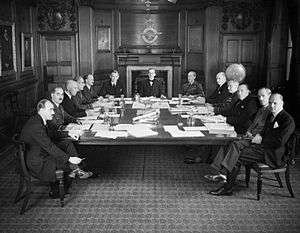Leslie Gossage
| Sir Ernest Leslie Gossage | |
|---|---|
| Born |
3 February 1891 Liverpool, England |
| Died |
8 July 1949 (aged 58) Sussex, England |
| Allegiance | United Kingdom |
| Service/branch |
British Army (1912–18) Royal Air Force (1918–44) |
| Years of service | 1912–44 |
| Rank | Air Marshal |
| Commands held |
Balloon Command (1940–44) Air Member for Personnel (1940) Inspector-General of the RAF (1940) No. 11 Group (1936–40) British Forces Aden (1935–36) School of Army Co-operation (1921–23) 1st Wing RFC (1917–19) No. 8 Squadron RFC (1916–17) No. 56 Squadron RFC (1916) |
| Battles/wars |
First World War Second World War |
| Awards |
Knight Commander of the Order of the Bath Commander of the Royal Victorian Order Distinguished Service Order Military Cross Mentioned in Despatches (5) Officer of the Legion of Honour (France) |
Air Marshal Sir Ernest Leslie Gossage, KCB, CVO, DSO, MC (3 February 1891 – 8 July 1949) was a former artillery officer who become a pilot in the Royal Flying Corps and later a senior officer in the Royal Air Force during the Second World War.
Early military career
Royal Field Artillery
It is believed that Gossage was a member of the Royal Field Artillery Special Reserve while a university student.[1] He was commissioned in 1912 as a second lieutenant in the Royal Field Artillery.[2]
First World War
When the First World War broke out in 1914 Gossage was still a young second lieutenant in the Royal Field Artillery, where he remained for the first year of the war.[1] However, on 12 May 1915, he was seconded to the Royal Flying Corps where he was assigned to No. 6 Squadron as a pilot.[1] By 5 September 1915 he had reached the rank of captain and had become a Flight Commander in No. 6 Squadron.[1] He was awarded the Military Cross in March the following year for his "consistent good and zealous work under bad weather conditions, both on patrol and when co-operating with the artillery in operations resulting in the capture of the enemy's position".
Following a promotion to major in 1916, Gossage was given command of No. 56 Squadron, later taking command of No. 8 Squadron in the same year.[1] In 1917 Gossage was promoted to lieutenant colonel and took command of the Royal Flying Corps' 1st Wing.[1] When the Royal Air Force was founded on 1 April 1918 Gossage transferred where he was appointed as a Staff officer in the Directorate of Operations and Intelligence.[1] He was awarded the Distinguished Service Order in 1919, and was four times mentioned in despatches during the war.[1]
Interwar years and Second World War

After the war he became Officer Commanding of the School of Army Co-operation before moving on to be Deputy Director of Staff Duties at the Air Ministry in 1928.[1] He was appointed Air Attaché in Berlin in 1930, Senior Air Staff Officer at Headquarters Air Defence of Great Britain and Senior Air Staff Officer at Headquarters RAF Iraq Command in 1934.[1] He went on to be Air Officer Commanding British Forces Aden in 1935 and Air Officer Commanding No. 11 Group in 1936.[1] He served in the Second World War as Inspector-General of the RAF, as Air Member for Personnel and then as Air Officer Commanding-in-Chief at RAF Balloon Command.[1]
Following his retirement from regular service with the Royal Air Force, Gossage agreed to be re-employed to assume the role of Commandant Air Cadets after the retirement of Air Commodore John Adrian Chamier. He served in this role until he stepped down in 1946.[1]
Notes
| Wikimedia Commons has media related to Leslie Gossage. |
| Military offices | ||
|---|---|---|
| Preceded by Charles Portal |
Commander, Aden Command 1935–1936 |
Succeeded by Wilfred McClaughry |
| Preceded by Philip Joubert de la Ferté |
Air Officer Commanding No. 11 Group 1936–1940 |
Succeeded by William Welsh |
| Preceded by Sir Charles Burnett |
Inspector-General of the RAF 1940 |
Succeeded by Sir Edgar Ludlow-Hewitt |
| Preceded by Charles Portal |
Air Member for Personnel 1940 |
Succeeded by Sir Philip Babington |
| Preceded by Owen Tudor Boyd |
Commander-in-Chief Balloon Command 1940–1944 |
Succeeded by William Gell |